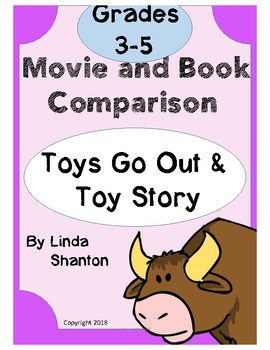Book and Movie Comparisons - Toys Go Out and Toy Story
Linda Shanton
46 Followers
Grade Levels
3rd - 4th
Subjects
Resource Type
Standards
CCSSRL.3.2
CCSSRL.3.3
CCSSRL.4.2
CCSSRL.4.3
CCSSRL.4.7
Formats Included
- PDF
Pages
9 pages
Linda Shanton
46 Followers
Description
This product is a great resource to use with the movie Toy Story and the book Toys Go Out by Emily Jenkins. The movie and the book are both based on the adventures of toys and what they learn about friendship.
Included in this packet:
* Venn Diagram to compare and contrast the book and movie
* Character traits organizers where students can infer a trait and then provide evidence from the book/movie to support their inference. There is an additional character trait organizer for struggling readers.
* Character creation - students create a new character for the movie
* Character friendships - Writing activity across movie and book.
* Film Review
My fourth grade students really enjoyed this activity. I hope yours do as well.
Look for more movie and book companions to come shortly.
Remember to leave feedback and earn TPT credits.
Follow my store to get the latest product information.
I appreciate you and your business. If you have any questions or concerns please contact me at linda.shanton1@gmail.com.
Thank you!
Included in this packet:
* Venn Diagram to compare and contrast the book and movie
* Character traits organizers where students can infer a trait and then provide evidence from the book/movie to support their inference. There is an additional character trait organizer for struggling readers.
* Character creation - students create a new character for the movie
* Character friendships - Writing activity across movie and book.
* Film Review
My fourth grade students really enjoyed this activity. I hope yours do as well.
Look for more movie and book companions to come shortly.
Remember to leave feedback and earn TPT credits.
Follow my store to get the latest product information.
I appreciate you and your business. If you have any questions or concerns please contact me at linda.shanton1@gmail.com.
Thank you!
Total Pages
9 pages
Answer Key
N/A
Teaching Duration
N/A
Report this resource to TPT
Reported resources will be reviewed by our team. Report this resource to let us know if this resource violates TPT’s content guidelines.
Standards
to see state-specific standards (only available in the US).
CCSSRL.3.2
Recount stories, including fables, folktales, and myths from diverse cultures; determine the central message, lesson, or moral and explain how it is conveyed through key details in the text.
CCSSRL.3.3
Describe characters in a story (e.g., their traits, motivations, or feelings) and explain how their actions contribute to the sequence of events.
CCSSRL.4.2
Determine a theme of a story, drama, or poem from details in the text; summarize the text.
CCSSRL.4.3
Describe in depth a character, setting, or event in a story or drama, drawing on specific details in the text (e.g., a character’s thoughts, words, or actions).
CCSSRL.4.7
Make connections between the text of a story or drama and a visual or oral presentation of the text, identifying where each version reflects specific descriptions and directions in the text.





